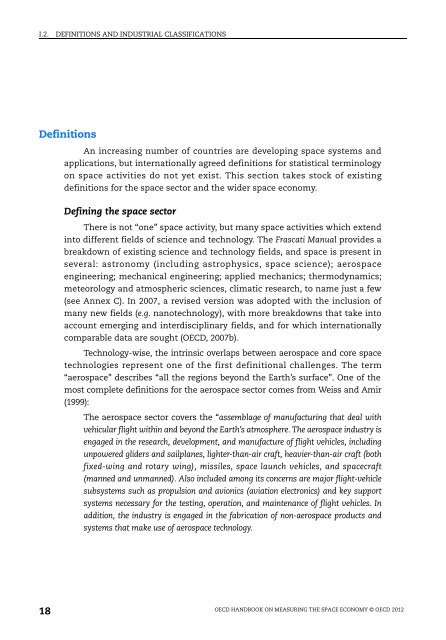OECD Handbook on Measuring the Space Economy - OECD Online ...
OECD Handbook on Measuring the Space Economy - OECD Online ...
OECD Handbook on Measuring the Space Economy - OECD Online ...
Create successful ePaper yourself
Turn your PDF publications into a flip-book with our unique Google optimized e-Paper software.
I.2. DEFINITIONS AND INDUSTRIAL CLASSIFICATIONS<br />
Definiti<strong>on</strong>s<br />
18<br />
An increasing number of countries are developing space systems and<br />
applicati<strong>on</strong>s, but internati<strong>on</strong>ally agreed definiti<strong>on</strong>s for statistical terminology<br />
<strong>on</strong> space activities do not yet exist. This secti<strong>on</strong> takes stock of existing<br />
definiti<strong>on</strong>s for <strong>the</strong> space sector and <strong>the</strong> wider space ec<strong>on</strong>omy.<br />
Defining <strong>the</strong> space sector<br />
There is not “<strong>on</strong>e” space activity, but many space activities which extend<br />
into different fields of science and technology. The Frascati Manual provides a<br />
breakdown of existing science and technology fields, and space is present in<br />
several: astr<strong>on</strong>omy (including astrophysics, space science); aerospace<br />
engineering; mechanical engineering; applied mechanics; <strong>the</strong>rmodynamics;<br />
meteorology and atmospheric sciences, climatic research, to name just a few<br />
(see Annex C). In 2007, a revised versi<strong>on</strong> was adopted with <strong>the</strong> inclusi<strong>on</strong> of<br />
many new fields (e.g. nanotechnology), with more breakdowns that take into<br />
account emerging and interdisciplinary fields, and for which internati<strong>on</strong>ally<br />
comparable data are sought (<str<strong>on</strong>g>OECD</str<strong>on</strong>g>, 2007b).<br />
Technology-wise, <strong>the</strong> intrinsic overlaps between aerospace and core space<br />
technologies represent <strong>on</strong>e of <strong>the</strong> first definiti<strong>on</strong>al challenges. The term<br />
“aerospace” describes “all <strong>the</strong> regi<strong>on</strong>s bey<strong>on</strong>d <strong>the</strong> Earth’s surface”. One of <strong>the</strong><br />
most complete definiti<strong>on</strong>s for <strong>the</strong> aerospace sector comes from Weiss and Amir<br />
(1999):<br />
The aerospace sector covers <strong>the</strong> “assemblage of manufacturing that deal with<br />
vehicular flight within and bey<strong>on</strong>d <strong>the</strong> Earth’s atmosphere. The aerospace industry is<br />
engaged in <strong>the</strong> research, development, and manufacture of flight vehicles, including<br />
unpowered gliders and sailplanes, lighter-than-air craft, heavier-than-air craft (both<br />
fixed-wing and rotary wing), missiles, space launch vehicles, and spacecraft<br />
(manned and unmanned). Also included am<strong>on</strong>g its c<strong>on</strong>cerns are major flight-vehicle<br />
subsystems such as propulsi<strong>on</strong> and avi<strong>on</strong>ics (aviati<strong>on</strong> electr<strong>on</strong>ics) and key support<br />
systems necessary for <strong>the</strong> testing, operati<strong>on</strong>, and maintenance of flight vehicles. In<br />
additi<strong>on</strong>, <strong>the</strong> industry is engaged in <strong>the</strong> fabricati<strong>on</strong> of n<strong>on</strong>-aerospace products and<br />
systems that make use of aerospace technology.<br />
<str<strong>on</strong>g>OECD</str<strong>on</strong>g> HANDBOOK ON MEASURING THE SPACE ECONOMY © <str<strong>on</strong>g>OECD</str<strong>on</strong>g> 2012
















![CQE=U]^\]Z: KAZAKHSTAN - OECD Online Bookshop](https://img.yumpu.com/3915768/1/190x253/cqeuz-kazakhstan-oecd-online-bookshop.jpg?quality=85)